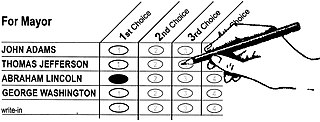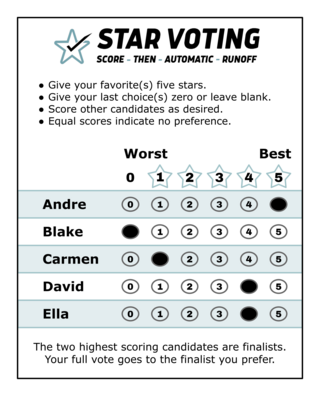
Approval voting is an electoral system in which voters can select any number of candidates instead of selecting only one.
Score voting, sometimes called range voting or average score voting, is an electoral system for single-seat elections. Voters give each candidate a numerical score, and the candidate with the highest average score is elected. Score voting includes the well-known approval voting, but also lets voters give partial (in-between) approval ratings to candidates.
Strategic or tactical voting is a situation where a voter considers the possible ballots cast by other voters in order to maximize their satisfaction with the election's results. For example, in plurality or instant-runoff, a voter may recognize their favorite candidate is unlikely to win and so instead support a candidate they think is more likely to win.
In political science, Duverger's law refers to the observation that political systems with only one winner that fail the sincere favorite criterion typically result in two-party rule. By contrast, systems that do not encourage lesser-evil voting or provide for proportional representation usually have more representation of minor parties in government.

A Condorcet method is an election method that elects the candidate who wins a majority of the vote in every head-to-head election against each of the other candidates, whenever there is such a candidate. A candidate with this property, the pairwise champion or beats-all winner, is formally called the Condorcet winner. The head-to-head elections need not be done separately; a voter's choice within any given pair can be determined from the ranking.

The monotonicity criterion, also called positive response or positive vote weight, is a principle of social choice theory that says that increasing a candidate's ranking or rating should not cause them to lose. Positive response rules out cases where a candidate loses an election as a result of receiving too much support from voters.
Ranked pairs, sometimes called the Tideman method, is a tournament-style system of ranked-choice voting first proposed by Nicolaus Tideman in 1987.
In an election, a candidate is called a Condorcet, beats-all, or majority-rule winner if a majority of voters would support them in a race against any other candidate. Such a candidate is also called an undefeated or tournament champion. Voting systems where a majority-rule winner will always win the election are said to satisfy the majority-rule principle, also known as the Condorcet criterion. Condorcet voting methods extend majority rule to elections with more than one candidate.
The participation criterion, also called vote or population monotonicity, is a voting system criterion that says that a candidate should never lose an election because they have "too much support." It says that adding voters who support A over B should not cause A to lose the election to B.
The majority criterion is a voting system criterion. The criterion states that "if only one candidate is ranked first by a majority of voters, then that candidate must win."
The mutual majority criterion is a criterion for evaluating electoral system. It requires that whenever a majority of voters prefer a group of candidates above all others, someone from that group must win.
The Borda count electoral system can be combined with an instant-runoff procedure to create hybrid election methods that are called Nanson method and Baldwin method. Both methods are designed to satisfy the Condorcet criterion, and allow for incomplete ballots and equal rankings.

Bullet, single-shot, or plump voting is when a voter supports only a single candidate, typically to show strong support for a single favorite.
Later-no-harm is a property of some ranked-choice voting systems, first described by Douglas Woodall. In later-no-harm systems, modifying the rating or rank of a candidate ranked below the winner of an election cannot change the result.
In voting systems theory, the independence of clones criterion measures an election method's robustness to strategic nomination. Nicolaus Tideman was the first to formulate this criterion, which states that the winner must not change due to the addition of a non-winning candidate who is similar to a candidate already present. It is a relative criterion: it states how changing an election should or shouldn't affect the outcome.
Instant-runoff voting (IRV), also known as plurality with elimination or plurality loser, is a ranked-choice voting system that modifies plurality by repeatedly eliminating the last-place winner until only one candidate is left. In the United Kingdom, it is generally called the alternative vote (AV). In the United States, IRV is often conflated with ranked-choice voting (RCV); however, this conflation is not completely standard, and social choice theorists tend to prefer more explicit terms.
In game theory and political science, Poisson-game models of voting are used to model the strategic behavior of voters with imperfect information about each others' behavior. Poisson games are most often used to model strategic voting in large electorates with secret and simultaneous voting.

STAR voting is an electoral system for single-seat elections. The name stands for "Score then Automatic Runoff", referring to the fact that this system is a combination of score voting, to pick two finalists with the highest total scores, followed by an "automatic runoff" in which the finalist who is preferred on more ballots wins. It is a type of cardinal voting electoral system.
Tideman's Alternative Method, also called Alternative Smith or Alternative Schwartz, is an electoral system developed by Nicolaus Tideman which selects a single winner using votes that express preferences.

The Center for Election Science (CES) is an American 501(c)(3) organization that focuses on voter education and promoting election science. The organization promotes electoral systems favored by social choice theorists, primarily cardinal voting methods such as approval and score voting. They have their early roots in effective altruism.






